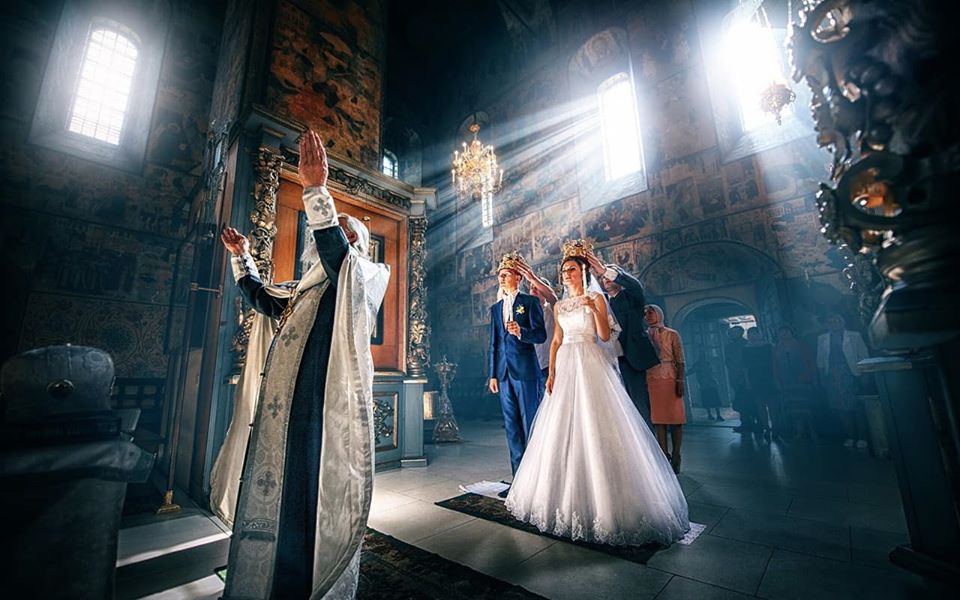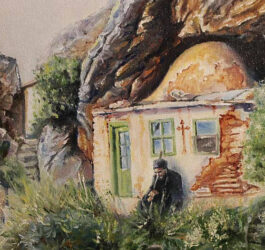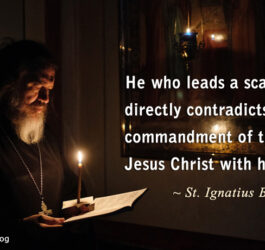
In Volume I, Doctrine of The Orthodox Faith four book series, Father Thomas Hopko provides a clear and thorough overview of the sources of Christian doctrines and the theology of the Orthodox Church. In the chapter titled “Man” Father Hopko explains how God created man in His “image and likeness” as male and female and gave them dominion over all of creation.
Man and woman were created as special creatures, superior to the angels and the animals. Men and women were designed to be God’s representatives in the world, to be co-workers with Him. God tasked them to reflect God in all of creation and “to make His presence, His will and His powers spread throughout the universe; to transform all that exists into the paradise of God,” writes Fr. Hopko.
Summary of Orthodox Teaching on Man and Woman:
- God’s creation of humans as male and female is essential for proper human life.
- We can understand what it means to be human only in light of the full revelation of Jesus Christ.
- Man and woman are created by God to live together in a union of being, life, and love.
- There can be no man without woman, just as there can be no woman without man.
- Differences between men and women are real and irreducible.
- The male and female are to be in spiritual as well as bodily union.
- The hostilities between man and woman that exist in the present world are due to sin.
- There are distinct roles of men and women as reflected in the created order and the Holy Trinity.
- Jesus Christ is truly the perfect man and the Last Adam.
- Through Christ man can become by divine grace all that God is by nature.
![]()
Man
by Fr. Thomas Hopko
(The Orthodox Faith – Volume I, Doctrine)
Man is God’s special creature. He is the only one “created in the image and likeness of God” (Gen 1.26). He is created by God from the dust at the end of the process of creation (the “sixth day”) and by the special will of God. He is made to breathe “the breath of life” (Gen 2.7), to know God, to have dominion over all that God has made.
God created humans as male and female (Gen. 1.27; 2.21) in order “to be fruitful and multiply” (Gen 1.28). Thus, according to Orthodox doctrine sexuality belongs to the creation which God calls “very good” (Gen 1.31), and in itself it is in no way sinful or perverse. It belongs to the very nature of humanity directly willed by God.
As the image of God, ruler over creation and co-creator with the Uncreated Maker, man has the task to “reflect” God in creation; to make His presence, His will and His powers spread throughout the universe; to transform all that exists into the paradise of God. In this sense man is definitely created for a destiny higher than the bodiless powers of heaven, the angels. This conviction is affirmed by Orthodox Christianity not only because of the Scriptural emphasis on man as made in God’s image to rule creation, which is not said about angels; but it is also directly affirmed because it is written of Jesus Christ, Who is truly the perfect man and the Last Adam (1 Cor 15.45) that “God has highly exalted him and bestowed upon him the name which is above every name, that at the name of Jesus every knee should bow, in heaven and on earth and under the earth, and every tongue should confess that Jesus Christ is Lord, to the glory of God the Father” (Phil 2.10–11).
It follows from belief in Jesus that man is created for a life far superior to that of any creature, even the angels who glorify God and serve the cause of man’s salvation. It is precisely this conviction which is affirmed when the Church hails Mary the Mother of Christ as “more honorable than the cherubim and beyond compare more glorious than the seraphim.” For what is glorified as already accomplished in the human Mary is precisely what is expected and hoped for by all men “who hear the word of God and keep it” (Lk 11.28).
Thus we see the great dignity of man according to the Christian faith. We see man as the “most important” of God’s creatures, the one for whom “all things visible and invisible” have been created by God.
It is the Orthodox doctrine that one can understand and appreciate what it means to be human only in the light of the full revelation of Jesus Christ. Being the Divine Word and Son of God in human flesh, Jesus reveals the real meaning of manhood. As the Perfect Man and the Last Adam, the “man from heaven,” Jesus gives us the proper interpretation of the story of creation given in the book of Genesis. For as the Apostle Paul has written, Adam finds his significance as “the type (or figure) of the one who was to come,” namely Jesus Christ (Rom 5.14).
Thus it is written, “The first man Adam became a living being”; the last Adam became a life-giving spirit. But it is not the spiritual which is first but the physical, and then the spiritual. The first man was from the earth, a man of dust; the second man (Christ) is from heaven . . . Just as we have borne the image of the man of dust, we shall also bear the image of the man of heaven (1 Cor 15.45–49).
According to Orthodox theology, to bear the image of God is to be like Christ, the uncreated Image of God, and to share in all of the spiritual attributes of divinity. It is, in the words of the holy fathers, to become by divine grace all that God Himself is by nature. If God is a free, spiritual, personal Being, so human beings, male and female, are to be the same. If God is so powerful and creative, having dominion over all creation, so human creatures, made in His image and according to His likeness, are also to exercise dominion in the world. If God exercises dominion and authority not by tyranny and oppression, but by loving kindness and service, so are His creatures to do likewise.
If God Himself is love, mercy, compassion and care in all things, so must His creatures, made to be like Him, also be the same. And finally, if God lives forever in eternal life, never dying, but always existing in perfectly joyful and harmonious beauty and happiness with all of creation, so too are human beings made for everlasting life in joyful and harmonious communion with God and the whole of creation.
According to Orthodox doctrine, human being and life is never completed and finished in its development and growth because it is made in the image and according to the likeness of God. God’s being and life are inexhaustible and boundless. As the Divine Archetype has no limits to His divinity, so the human image has no limits to its humanity, to what it can become by the grace of its Creator. Human nature, therefore, is created by God to grow and develop through participation in the nature of God for all eternity. Man is made to become ever more Godlike forever, even in the Kingdom of God at the end of this age, when Christ will come again in glory to raise the dead and give life to those who love Him.
Thus the holy fathers of the Orthodox faith taught that whatever stage of maturity and development man attains and achieves, whatever his power, wisdom, mercy, knowledge, love, there continually remains before him an infinity of ever-greater fullness of life in the most blessed Trinity to be participated in and lived. The fact that human nature progresses eternally in perfection within the nature of God constitutes the meaning of life for man, and remains forever the source of his joy and gladness for all eternity.
It must be mentioned at this point as well that according to Orthodox Christian doctrine, the fact that humans are created male and female is the direct will of God and is essential for proper human life and activity as reflective of God. In a word, human sexuality is a necessary element in human being and life as made in the image of God. This does not mean that there is any sort of sexuality in God, but it does mean that human life must be sexual—male and female—if it will be what God Himself has made it to be.
Man and woman, male and female, are created by God to live together in a union of being, life and love. The man is to be the leader in human activities, the one reflecting Christ as the new and perfect Adam. The woman is to be man’s “helpmeet,” the “mother of all living” (Gen 2.18; 3.20). Symbolized in the relationship of Mary and the Church, the New Eve, to Christ, the New Adam, as the one who inspires man’s life and completes his being and fulfills his life, the woman is not man’s instrument or tool. She is a person in her own right, a sharer of the nature of God, a necessary complement to man. There can be no man without woman—no Adam without Eve; just as there can be no woman without man. The two exist together in perfect communion and harmony for the fulfillment of human nature and life.
The differences between men and women are real and irreducible. They are not limited to biological or physical differences. They are rather different “modes of existence” within one and the same humanity; just as, we might say, the Son and the Holy Spirit are different “modes of existence” within one and the same divinity, together with God the Father. The male and female are to be in spiritual as well as bodily union. They are to express together, in one and the same humanity, all of the virtues and powers that belong to human nature as made in the image and according to the likeness of God. There are no virtues or powers that belong to man, and not to woman; nor to woman and not to man. All are called to spiritual perfection in truth and in love, indeed in all of the divine virtues of God given to His creatures.
The hostilities and competitions between man and woman that exist in the present world are not due to their respective “modes of existence” as created by God. They are due rather to sin. There should be no tyranny of men over women; no oppression, no servitude. Just as there should be no striving of women to be men, and to hold the male position in the order of creation. There should be rather a harmony and unity within the community of being with its natural created order and distinctions.
The oneness of nature with the distinction of various modes of being within Divinity, the Most Holy Trinity. For in the Divinity of the Trinity itself there is a perfect unity of nature and being, with real distinctions between the Father and the Son and the Holy Spirit as to how each of the Divine Persons lives and expresses the common nature of God.
There is an order in the Trinity. There is even a hierarchy if we do not take this term to mean some difference in nature between the Father, Son, and Holy Spirit, but merely the way in which the Divine Persons relate to one another and to man and the world.
For in the Trinity itself the Father alone is the “source of divinity.” The Son is the expression of the Father and is “subject” to Him. And the Holy Spirit, of one essence and fully equal with the Father and the Son, is the “third” Person who fulfills the will of the Father and the Son.
The Three Divine Persons are perfectly equal. This is a dogma of the Church. But they are not the same, and there is an ordered relation between them in which there are “priorities” in being and acting which not only do not destroy the perfection and perfect unity of the Godhead, but even allow it and make it to be perfect and divine. It is the Trinitarian Life of God which is the Divine Archetype and Pattern for the being and acting of male and female within the order of creation.
_______________________________________________
Emphasis of key words and phrases, and organizational edits—broke up larger paragraphs into smaller ones—to optimize readability made by Chris Banescu.




I am engaged to be remarried in the Fall. Thank you for this excellent article I can share with my fiance.
Men and women are different. Thank God. Viva la differnce!
At the risk of being called “hetero-normative”, … this difference has preserved life since Creation.
It’s almost as if there were an intelligent design and purpose to it.
Homosexual marriage is faux marriage. Counterfeit.
Homosexuality is an evolutionary dead end.